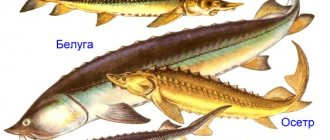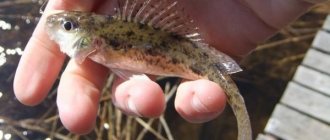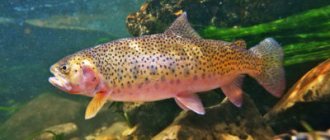Oceans, seas, rivers and lakes, even small ponds - the entire hydrosphere of the Earth is a wonderful world, mostly hidden from prying eyes. The bottom of many reservoirs has been practically unexplored, but we cannot deny that complete freedom and weightlessness reign there. Boundless expanses, coral reefs, underwater waterfalls, smart dolphins, deadly jellyfish, luminescent microorganisms - the wonders that the World Ocean conceals.
Not only large seas, but also rivers and lakes also surprise with the grandeur and diversity of flora and fauna. Here you can find everything your heart desires: small minnows that can easily fit into a child’s small hand, and real giants that are difficult for even several men to lift. Such fish can give sharks a run for their money.
This article will describe the real masters of the water element: TOP 10 largest freshwater fish in the world. Interesting? Then read on!
10.Carp (Cyprinus carpio)
Carp (carp) is a large omnivorous fish that lives in fresh water bodies with stagnant water and a muddy bottom.
The body is covered with large scales and has a golden hue. A very voracious fish, capable of eating almost the whole day. Carp eat young shoots of reeds and other aquatic plants, as well as mollusks, aquatic insects and even the eggs of other fish and frogs. Since the average size of this fish is small, it ranks last among the ten largest freshwater fish in the world. The largest carp was caught in 2015 in Hungary. His weight was 48 kg.
The largest river fish in Russia
Catfish
The largest freshwater fish or river monsters are not deprived of their presence in Russian freshwater reservoirs, which include large rivers and reservoirs. And the conventional pedestal in the hierarchical table of such giant fish is headed, of course, by the catfish.

The largest specimens of catfish are, of course, real monsters that attack all living things, sometimes not disdaining carrion, although catfish are predominantly real predators and hunters, attacking fish, small animals and birds. Willingly eats catfish and frogs. Apparently, cases of these fish feeding on drowned animals and dead fish are mostly associated with seasonal or climatic disruptions, which have recently become frequent and disrupt the usual weather conditions. And this, in turn, affects the timing of fish reproduction and other underwater laws, which often creates poor conditions for fattening catfish. In addition, discharges of subsoil water and runoff from enterprises kill underwater fauna, which negatively affects the reproduction and life of mollusks. And catfish very willingly eat various bivalve mollusks such as toothless mollusks and pearl barley.

The largest fish in Russia - catfish - have terrible strength, impressive size and greed, which often borders on recklessness. In the literature, cases of catfish attacks even on humans were described, which served to create legends and literary works, which quite harshly and with dreary monstrous realism described the hunt of catfish for children who were on rafts where their mothers washed clothes. It was as if they were licking the catfish of children from rafts. Then there was a merciless hunt for these monsters. Children were found or not found in the stomachs of predators, but all large fish were completely destroyed. There are descriptions, it seems, from V.K. Arsentyev, cases of attacks by huge catfish on bears fishing in the shallows. This seemingly fairy tale, meanwhile, could well have taken place, given the size of the catfish and its strength in its natural environment, while a bear, even the strongest, loses its advantage in water, especially if the river has a strong current. There are also cases described when a catfish tried to drag an adult under water by grabbing his leg. It was a villager and luckily for him, he had a sickle in his hands, with which he fought off the catfish. And many such cases have been described, however, similar attacks by predators date back to earlier centuries of Russian history, when catfish reached a weight of 400 kilograms and a size of up to 5 meters. Large Russian catfish fit into the category of the largest river fish in the world.

But nowadays, catfish weighing 30 kilograms are considered large prey, and specimens weighing 50-100 kilograms are already called trophy fish. And you don’t come across such fish very often, if not rarely. Even more rare are catfish weighing more than 200-250 kg, but, according to huntsmen, such fish are still found in the Volga waters. In Russia, the places where trophy catfish are caught are the deep channels and eriks of the Lower Volga, as well as the main Volga channel with deep snags and steep bottom reliefs.
There is something mystical in the appearance of this large scaleless fish with a large head and a huge mouth, where numerous sharp teeth in the form of a brush are visible. Two long whiskers flutter in the water above the mouth, and four more antennae are visible under the lower jaw. And among this powerful composition of the appearance of an underwater monster, the small eyes somehow look ridiculous... It seems at first glance that these eyes are kind, like in fairy tales with the mention of “catfish” and other characters. But this is only at first glance. There is merciless rage in the eyes of the catfish. The head of a catfish is the main and largest part of the fish’s “figure”. Everything else is occupied by a long tail, wriggling like a snake, and a sometimes white marbled belly. The back of the catfish casts blued steel.

Photos of the largest river fish often show catfish. And this is most likely connected with the same question: do real cannibal catfish exist in reality? These huge fish are too mysterious and there are so many fables about them. But there is still evidence of catfish attacks on people in our time, given that giant individuals are still found. According to US zoology specialist David Wheeler, there are catfish weighing half a ton and measuring more than six meters. Such facts are given in his book about catfish of unprecedented sizes that still live in large bodies of water.
And in our time, catfish attacks on animals occur, the victims of which are usually pets and young cows, sheep, goats, as well as adults. People also became targets of attacks by underwater predators, and most often these were children. In the middle of the summer of 1982, researchers and rangers of the Khopyorsky Nature Reserve witnessed a catfish attack on a young deer and its death when a huge fish pulled it under water. Bears crossing the river also became victims of catfish. This is still talked about in the Siberian region.
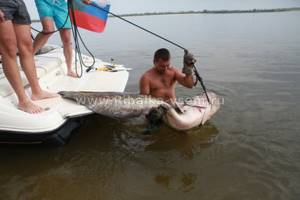
So, the largest freshwater fish is the catfish? Among other things, and a cannibal? Quite possible. Here are some more facts, moreover, from very recent history. This happened in the Voronezh region at the end of the summer season, in the 90s. Near the village of Kulakovo, a boy and a woman became victims of an attack by a huge killer catfish. They swam in the evening in hunting areas of man-eating catfish.
Similar cases of people disappearing in the evening were recorded in China at a large reservoir. People went swimming and did not return from the water. The mystery of their disappearances was solved when a giant catfish measuring three meters in size was caught with human remains in its stomach. One head of this catfish was a meter in size.
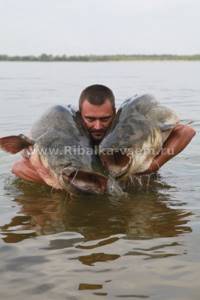
It is difficult to judge whether this is true or not, but according to some sources, a five-meter catfish was found on the side of the vessel in a tugboat that sank on the river, which had made a hole in the hull. In the stomach of the monster, the remains of three Polish tourists were found, who, after the disaster with the tugboat, transferred to a small rescue vessel, but never made it to the shore. It was on the Dnieper.
Beluga
The list that includes the largest freshwater fish or river monsters should include the beluga. It would, of course, be in first place in size among the fish of Russia. But this huge fish is not a permanent and typical river inhabitant, since it is a migratory fish species and enters rivers only to spawn. Meanwhile, in the local history museum of the Republic of Mari El, among the exhibits there is a beluga weighing a ton, once caught in the Volga. But this is not the limit of the weight and size of the beluga. According to unspecified and unofficial data, not so long ago individuals weighing up to 2 tons and up to 7-8 meters in length were encountered. Confirmed data indicate the capture of the largest specimen of this fish, weighing one and a half tons and 4.2 meters long. Some of the largest belugas are truly long-livers, as their age can be 100 years.
The largest river fish in Russia, although they do not constantly live in rivers, nevertheless spend a very large part of their lives there. This is due to the characteristics of reproduction. Being inhabitants of the Caspian, Black, Azov and, according to some information, the Adriatic seas, belugas come to spawn mostly in the Volga, as well as in the rivers: Ural, Terek and Kura. But if earlier these powerful and ancient fossil fish rose quite high along the Volga, to the middle reaches and higher, then with the emergence of the Volga cascade of dams and hydroelectric stations, the rise of the beluga stopped, at least to the previous levels.
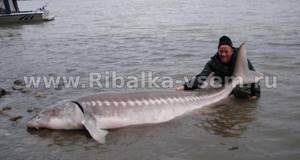
The fish passages didn't help either. In addition, some dams either did not have them at all or did not work at full capacity. For example, at the Cheboksary hydroelectric power station in the first years, instead of fish passage structures, only an 8 cm grid was installed, on which passing large fish were cut and died, falling to the bottom under the release of water from the dam.
The largest river fish in the world hardly reached the size of the Russian beluga, at least those individuals that entered our rivers in the 18th and 19th centuries. Meanwhile, in our time, these valuable sturgeon fish, which once supplied a lot of tasty meat and delicious black caviar, are on the verge of extinction, despite the bans. And in the good old days, even a simple peasant could afford to taste the delicious beluga meat and the same delicious black caviar, and in large quantities. This happened one fine day in the year one thousand eight hundred and ninety-one, when a strong wind from the shore unexpectedly and quickly drove water from the bay of the Azov Sea near Taganrog. In a shallow puddle in the bay, this lucky guy found a beluga weighing 20 pounds (327 kg). There was almost 50 kilograms of black caviar in it. This is where you could eat plenty of real fish and black caviar, even with a tablespoon, simply!..
Siberian taimen
The largest freshwater fish in Russia are also found in Siberian rivers. And the largest and most beautiful predator of icy waters is taimen. This is the most ancient fish of all salmonids, since taimen lived about 18 million years ago. Most species and subspecies of taimen, including lenok and char, are predominantly freshwater, with the exception of the Sakhalin taimen, which at certain times adheres to river mouths and the desalinated part of the sea.

In our country, taimen live in the rivers of Siberia, as well as in the rivers of the Amur basin. These powerful and incredibly beautiful fish are the object of sport fishing according to the “catch and release” principle. This strict principle is a vital necessity, since the Siberian taimen is already an endangered fish species.
Among Russian fish, taimen stand out for their size and weight. The largest specimens recently reached a weight of a hundredweight and a length of two meters and a hook. Since 1993, the record has been held for the largest taimen caught on sports gear and released back into the waters of the river. The weight of this trophy fish was 41.95 kg. However, no, no, and information will get through, they say, they caught a taimen weighing 50 kg, or even 80 kilograms, somewhere in a mountain river. In a word, taimen is the largest freshwater fish in our country beyond the Ural ridge.
Taimen are true predators, capable of swallowing large fish. Outwardly, this large fish looks like a living torpedo, for which strong currents and rapids of mountain rivers are no obstacle. The usual coloring of taimen consists of brown tones on the back and silver on the sides with dark spots. During the mating season, these fish become even more beautiful. They are noticeable and bright thanks to their red, almost orange pelvic fins, as well as the juicy red with a copper tint – the anal and caudal fins.
The element of taimen is icy mountain rivers and similar lakes. Hunting places are holes immediately beyond the rapids, where tired small fish roll down and become prey for a predator. Taimen also stay in small groups and in places with an uneven bottom on stretches and even in river bays. If only there was depth in such a bay.
Pike
The category of the largest freshwater fish also includes pike. According to Leonid Pavlovich Sabaneev, pike weighing 48-64 kg were found not so long ago in northern and Siberian rivers. And predators weighing 100 pounds and weighing 20 kg are not particularly rare in Russian waters, especially in the expanses of the Volga reservoirs. The pike caught during the reign of the German Emperor Barbarossa, which was 5.7 meters long and weighed 140 kg, is considered legendary. She was ringed and thrown into the lake. The pike lived for more than 200 years in this lake and, when caught, was whitish in color, as if faded with age. The skeleton and ring of this pike are still kept in one of the museums in Germany. True, there are doubts about the authenticity of these artifacts, since the maximum age of pike is estimated by leading ichthyologists at 33 years.
Even in forest peat lakes there were giant pikes. The 30-kilogram pikes of Lake Luzhier were written about in the pre-war newspapers of the Mari Volga region. Large in area, but only 2-3 meters deep, this peat interdune lake still remains a haven for large pike. The lake's tenants, who set themselves the goal of completely catching predators and introducing cultivated fish species, failed to cope with this task. The lake seemed to have a second bottom where predators were hiding. And in the process of seine fishing, fishermen saw giant fish exiting and jumping through the net, and also observed live logs in shallow areas. Log pikes came out onto the shallows to escape the net. And the fishermen simply did not dare to catch them, despite the reach of the prey. A similar giant pike, which can be judged not only by descriptions and stories, was caught in Lake Ilmen. She weighed 34 kilograms. And the authenticity of the capture of a large predator is confirmed by a black and white photograph, which can easily be attributed to the series - photographs of the largest river fish.
Predators weighing 12-16 kg even now often become prey for winter pike fishermen.
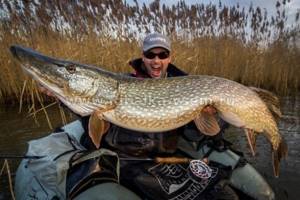
Carp and carp
According to the information presented in the books of L.P. Sabaneeva, carp and its cultivated variety, carp, were in ancient times truly gigantic in size and weight. The record holder of that time can be called a carp weighing more than three pounds, or more precisely, 55.6 kg. This fish was caught with hooks, gear that is now considered poaching. There were rumors of a 68.5 kg carp caught in a net. Nowadays, these fish also come in large sizes and heavy weights. At least, carp weighing 20-30 kg are considered not very rare prey, especially in the lower reaches of the Volga, and are called trophy fish that every angler dreams of catching.
These powerful and large fish, encased in strong silver-golden scales, are also included in the category of the largest freshwater fish, only among the relatively peaceful underwater inhabitants. Why is it conditional? Any, even the most herbivorous and peaceful-looking fish, having reached a certain age and size, becomes to some extent a predator and is not averse to swallowing fry.
In addition to the Volga delta, large carp are found in paid reservoirs, where, with proper feeding and regulated fishing, they quickly reach large sizes and weights, since the peculiarity of these fish is their rapid growth.

9.Paddlefish (Polyodon spathula)
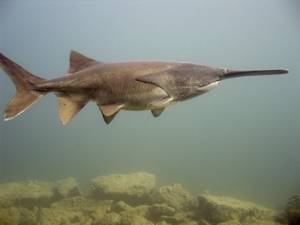
The paddlefish is a large freshwater fish that inhabits bodies of water in the eastern United States, particularly the rivers flowing into the Gulf of Mexico. Most common in Mississippi and its associated lakes. On average, adults reach a size of 221 cm and a weight of 90.7 kg. They live long, up to 55 years. These freshwater fish are the only sturgeon species that feed on zooplankton, phytoplankton, as well as the remains (detritus) and secretions of invertebrate animals.
Burbot

The largest representative of the species was caught in Siberia in 1967. Its weight was 30 kg and its length was 120 cm. Other cases were also recorded. 1985, Lake Onega, a burbot weighing 16 kg was caught. 1910, Lake Ladoga, a fish weighing 10 kg was caught. Catching such large burbot is an incredible success, because their average weight is 3-4 kg .
Interesting: Piranhas - description, species, habitat, teeth, photos and videos
Burbot is a northern fish. It loves cold water, so it rarely appears in the south. Lives in Siberian rivers and Lake Baikal. Also found in northern Europe: Finland, the Baltic states, and the Leningrad region.
8. Siberian taimen (Hucho taimen)
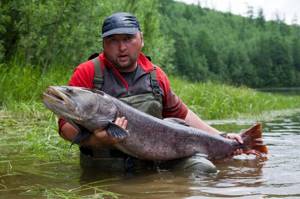
Siberian taimen (Russian salmon) is a species of predatory freshwater fish belonging to the salmon family. These fish inhabit the fast and cold waters of Siberia, Altai and the Far East. It is not in vain that it is considered the largest salmon in the world: such a fish can be 1 m in length and weigh 50-60 kg. The taimen is not whimsical in its choice of food; it preys on all types of fish that are smaller in size. It has different colors, but you can recognize it by its olive-green head, reddish-brown tail and 8-10 transverse stripes on the sides. The lifespan of taimen is significantly longer than that of other salmon. Thanks to this, fish can grow to above average sizes.
The largest taimen in the world was caught in the Krasnoyarsk Territory on the Kotui River in 1943. The weight of this fish was 105 kg and the length was 210 cm.
Saw-nosed ray - 7 m
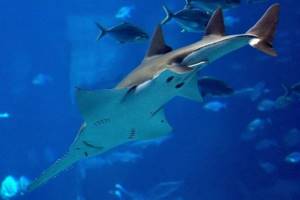
These little-studied cartilaginous fish reach enormous sizes. However, most of their length consists of long, saw-like noses.
In appearance, the sawnose ray resembles a sawnose shark. However, the latter could well call the stingrays “fry” and argue that “it was better before.” And all because saw-nosed sharks appeared much earlier than saw-nosed rays - even at the border of the Jurassic and Cretaceous periods, while saw-nosed rays arose 60 million years later.
These fish are big fans of fishing in troubled waters, literally. Saw-tailed rays spend most of their lives at the bottom, not being interested in what is happening on the surface. And if young individuals prefer shallow water, then adult sawfish rays descend to a depth of 40 meters or more.
7.Armored pike (Lepisosteus osseus)
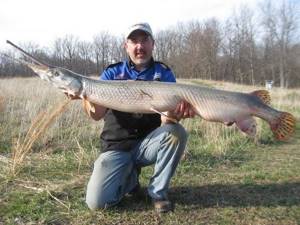
The armored pike is a ray-finned fish of the armored family.
Swims in fresh and brackish waters of Central and North America. This is not only one of the largest freshwater fish on the planet, but also one of the most ancient - the ancestors of this species lived on Earth more than 100 million years ago. It got its name for its truly terrifying appearance: its long body is covered with thick, shell-like scales, and its sharp muzzle has powerful jaws with four rows of teeth. Armored freshwater pikes can reach 3 m in length and weigh up to 136 kg. It mainly eats small fish, but can also attack humans.
lake salmon
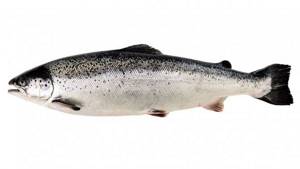
Lake salmon is not even a species or subspecies, but a morph of Atlantic salmon. Morph is a type of animal that has persistent differences within a species or population; this category includes melanists, albinos, local varieties, and so on. The main difference between lake salmon and Atlantic salmon is that they feed in lakes rather than in salt water bodies. The young of such fish do not go to the sea when they grow up; they live in the lake and then spawn in the rivers that flow into it. In Russia, such salmon live in lakes Ladoga and Onega, Segozero and a number of other northern reservoirs. Fishing is only possible within Lake Onega; the remaining populations are listed in the Red Book .
Interesting: The most charming dog breeds - list, description, photos and videos
Lake salmon are smaller in size than sea salmon, with an average weight of 3-4 kg. The maximum officially noted is 7 kg, but fishermen claim otherwise, saying that they have caught fish weighing up to 10 kg or more. However, such statements should be treated with caution, because Baltic salmon, for example, also goes to spawn through Ladoga and Neva - rivers flowing into Lake Ladoga. And when switching to freshwater mode, the fish changes color; representatives of the oceanic stock are easily confused with “indigenous” freshwater inhabitants of larger sizes. Such individuals can also end up in Lake Onega, and a person may encounter an anadromous fish, considering it to be local freshwater.
6. Nile perch (Lates niloticus)
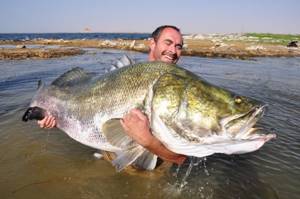
Nile perch is the largest freshwater fish in the world from the genus Perciformes. Found in water bodies of Africa (Nile, Senegal, Congo, etc.). We are used to catching perches “on the palm” and larger, but this species grows up to 2 m in length and weighs up to 200 kg. The average length of the African freshwater perch will be 120-140 cm. The fish has a silver color with a blue tint. It feeds on smaller fish, insects, crayfish, and also does not disdain its relatives.
Mississippi girt
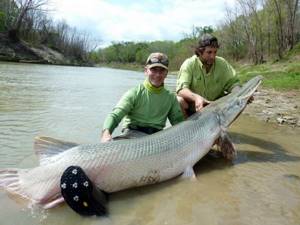
The Mississippi shellfish or alligator gar is a species of large freshwater fish common in the lower Mississippi River valley and its tributaries in North and Central America. This is a very fast and strong, but shy fish. According to experts, the Mississippi shellfish can grow up to 3 m in length and weigh more than 130 kg. In 2011, the largest shellfish caught was officially registered, its length was 2.572 m, weight 148 kg. It feeds mainly on fish, small mammals, birds, turtles, etc. There are known cases of attacks on children, fortunately, they never ended fatally. Included in the list of prehistoric fish that were considered extinct.
1
5.Brazilian arapaima (Arapaima gigas)
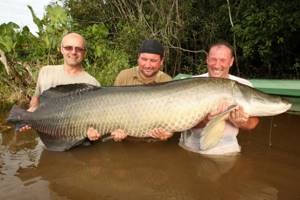
The Brazilian arapaima is a tropical freshwater fish from the Aravanidae family. Distributed in lakes and rivers of South America. The body of this fish has a greenish color in the front, with a smooth transition to red in the tail, and incredibly durable scales. Thanks to its reliable protection, the arapaima coexists with such ferocious predators as piranhas. It mainly feeds on fish, and on occasion birds and small animals. The average length is 2 meters, but there are individuals up to 3 meters and weighing 200 kg.
The Brazilian arapaima has a unique feature - it is able to breathe atmospheric air.
Arapaima
Considered a river monster of the Amazon. It was first noticed by European scientists at the beginning of the 19th century. However, they still have not been able to study all the features of this fish.
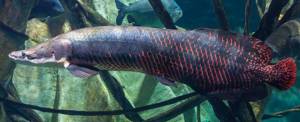
Arapaima is able to use atmospheric air as the main source of oxygen. This feature allows it to be a universal predator and hunt not only fish, but also other animals, including birds. Arapaima grow up to 3 meters in length, their weight is 150-190 kg.
4.Giant catfish (Pangasianodon gigas)
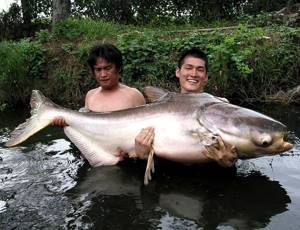
Mekong catfish (shilbo catfish) is a ray-finned fish of the pangasian catfish family.
Inhabits the rivers of Thailand: Mekong and Tonle Sap. The largest specimen was 2.7 m in length and weighed 293 kg. These freshwater fish eat phytoplankton and algae and also prey on fish and small animals. Due to excessive fishing, there is a possibility of complete extinction of this species. According to some data, over the past 14 years, its population in the world has decreased by 80%. Therefore, the Shilbo catfish is included in the International Red Book.
Carp
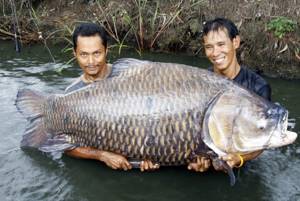
Carp is the common name for freshwater fish of the carp family. They are widely distributed in various bodies of water around the world. They prefer quiet, stagnant or slow-flowing waters with a hard clayey and slightly silted bottom. Capable of growing up to 1.2 meters in length and weighing more than 100 kg. They feed on mollusks, crustaceans, worms and insect larvae. The largest carp caught by a British angler in 2013 weighed 45.59 kg.
9
3.Common catfish (Silurus glanis)
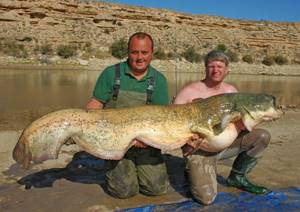
The common catfish is a large bottom-dwelling fish without scales that lives in the deep fresh waters of lakes and rivers in Europe, Asia and parts of Russia. This fish is a real giant among aquatic creatures. Therefore, it is included in the same list with the largest freshwater fish in the world. With great depth and sufficient food, it can grow up to 5 m long and weigh up to 400 kg. There is no official confirmation of the second figure, but there are many eyewitness accounts. For such sizes, you need a lot of food. Some sources say that catfish feed exclusively on carrion. In fact, these fish prefer to hunt small fish, crustaceans, waterfowl, aquatic insects, small mammals and even their relatives.
Catfish are very large predatory fish with an aggressive character, living in fresh water, including in places where people bathe. In this regard, they pose a danger to humans, because may cause quite serious injuries. There is official evidence of attacks by two-meter catfish on people.
Giant Mekong catfish and common catfish
These two species shared 5th place. The rivers and lakes of Thailand are considered the home of the giant Mekong catfish. It is the largest species among its relatives, and for this reason it is often considered and studied separately from the rest. The body length of the fish reaches 4.5-5.0 meters, weight – up to 300 kg. Fish and small animals are the favorite delicacy of the giant catfish.

The common catfish has a body length of up to 5 meters and weighs up to 350 kg. Inhabits water bodies of the European part of Russia, as well as eastern and central Europe.
2.White sturgeon (Acipenser transmontanus)

The white sturgeon is the third largest in the sturgeon family. Inhabits the fresh waters of North America and is considered the largest cultural heritage of British Columbia. The sturgeon loves to live in the calm waters of the west coast and is large in size: up to 6 m long and weighing up to 816 kg. The fish is very aggressive, has a characteristic gray color with white spots and diamonds on the sides and back. Sturgeons live for a very long time, longer than humans, up to 100-110 years, and can reproduce only from the age of 14 (males) and 18 (females). The predator eats mollusks, crustaceans, worms and fish.
White sturgeon
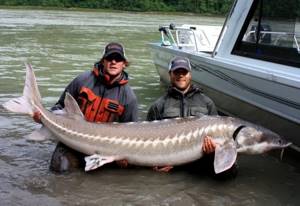
Fifth place in the list of the largest freshwater fish on the planet is occupied by the White sturgeon - a species of fish of the sturgeon family, the largest freshwater fish in North America. Inhabits the bottom of slow-moving rivers and bays along the west coast of North America. The white sturgeon can grow up to 6.1 m long and weigh 816 kg. It feeds mainly on fish, crustaceans and mollusks.
4
1. Beluga (Huso huso)
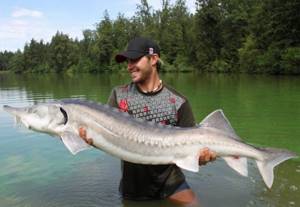
Beluga is a large freshwater fish from the sturgeon family that lives in the Caspian, Black and Azov seas. This fish grows to enormous sizes: 4-5 meters in length and weighs up to one and a half tons. According to unconfirmed reports, there were individuals 9 m long and weighing up to 2 tons. That is why the beluga is the largest freshwater fish in the world. It feeds on different types of fish and shellfish, but prefers sprat, gobies, and herring. Beluga is a valuable commercial fish because... it contains the most expensive caviar in the world - black. The cost of a kilogram of black caviar in Europe can exceed 7,000 euros. Beluga is listed in the Red Book.

Another large commercial fish, kaluga (Huso dauricus), . We did not include it in the ranking of the largest freshwater fish in the world to make our TOP 10 more diverse. Lives in the Amur River. Grown-up individuals feed on minnows and other small fish, and later they eat silver carp, carp, salmon, grass carp, and sometimes their relatives. It can grow up to 5-6 meters long, and the maximum recorded weight of the “Queen of Amur” is 600 kg. This giant was caught by a Chinese fisherman in 2012. There is an assumption that previously there were fish weighing up to a ton. Included in the international and Russian Red Book. Kaluga is a freshwater fish, but is able to adapt to life in salty sea water.
+Grey bull shark
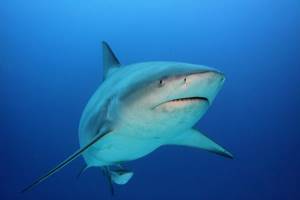
The gray bull shark (snout shark) lives in tropical and subtropical waters of all oceans. Belongs to the family of gray sharks, whose representatives can live in both salt and fresh water and is the largest of them. Among all species of living sharks, it has the greatest bite force - up to 6000 Newton. According to some data, it reaches a length of 3.5-4 m and a weight of up to 400 kg. Females are larger than males, aggressive and merciless. The bull shark hunts in the shallowest freshwater bodies near sandy beaches. Although this is a large fish, we did not include it in the rating, since freshwater rivers and lakes are not its main habitat.
- The smallest freshwater fish in the world is the dwarf pandaka (Pandaka pygmaea) . It has an almost transparent colorless body. Found in the lakes of the Philippine island of Luzon. It grows no more than 1 centimeter and weighs 4-5 mg.
- The largest fish in the world, among the inhabitants of both fresh and salt waters, is the whale shark (Rhincodon typus) .
Beluga

Beluga belongs to the sturgeon family. This large fish lives in the depths of the Azov, Black and Caspian seas. Beluga can weigh a ton. Moreover, its body length will be more than 4 meters. True long-livers belong to this species. The predator can live up to 100 years. In food, beluga prefers such types of fish as herring, gobies, sprat, etc. The fish also likes to eat mollusks, and sometimes hunts seal pups - pups.
Interesting facts about the largest freshwater fish in the world.
Related Posts
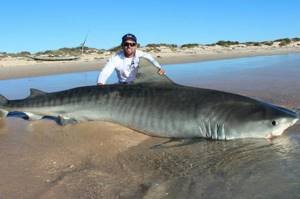
The largest sharks in the world Top 10 Most dangerous fish in the world
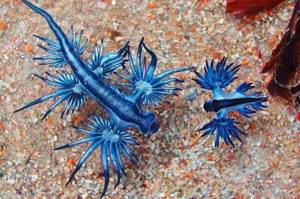
Top 10 Most Beautiful Fishes in the World
Great white shark - 6.4 m
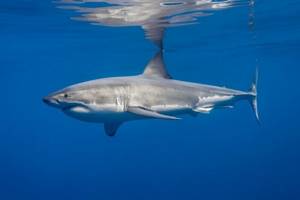
It is impossible to accurately measure the length of a great white shark, as there are few people willing to approach this living killing machine with a tape measure. According to unconfirmed information, the length of a great white shark can reach 10 meters, but the recorded record is 6.4 meters.
It may not be the biggest fish in the world, but it is certainly the most dangerous. Most shark-related attacks on humans are caused by white sharks. Most often it encounters people in coastal waters. By the way, Steven Spielberg’s famous film “Jaws” is just about a giant man-eating white shark.
Of course, in real life, people are not the favorite delicacy of white sharks, but unprovoked attacks on swimmers and fishermen by this dangerous predator are quite common.
The great white shark is the most feared predator in its ecosystem, although killer whales provide them with worthy competition, and sometimes even kill due to teamwork and speed of action. It’s a pity that killer whales are not fish, but mammals, otherwise they would take their rightful place on our list of the largest fish in the world. The video clearly shows the differences between a great white shark and a killer whale.
Som
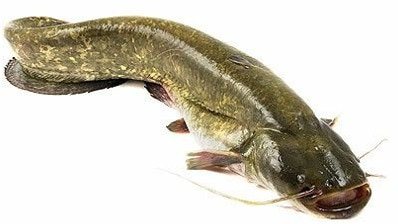
The most legendary fish, surrounded by many myths. Catfish are predators. Their diet consists of more than just small fish. Large old catfish can hunt ducks sitting on the water, animals that come to drink, and small pets. Catfish live a very long time and grow throughout their lives. They say that in the 19th century, in Russia, a catfish weighing 400 kg was caught. The officially registered catfish that was caught weighed 306 kg, was more than 3 meters long and was about 80 years old. Modern catfish weighing over 100 kg are extremely rare.
Interesting: The biggest cats in the world - list, sizes, names, where they live, photos and videos
